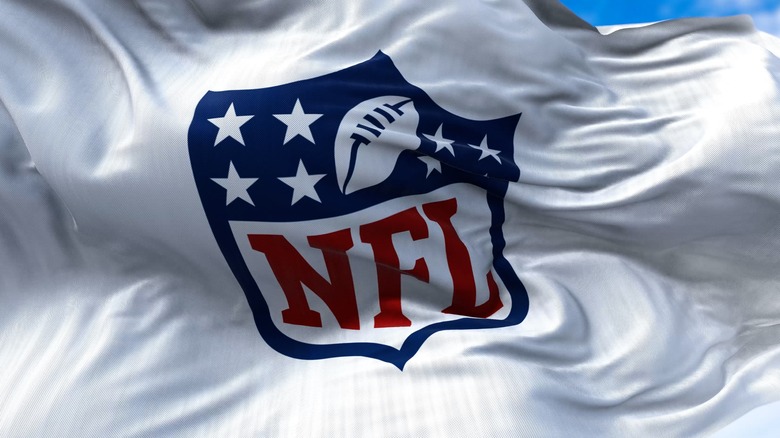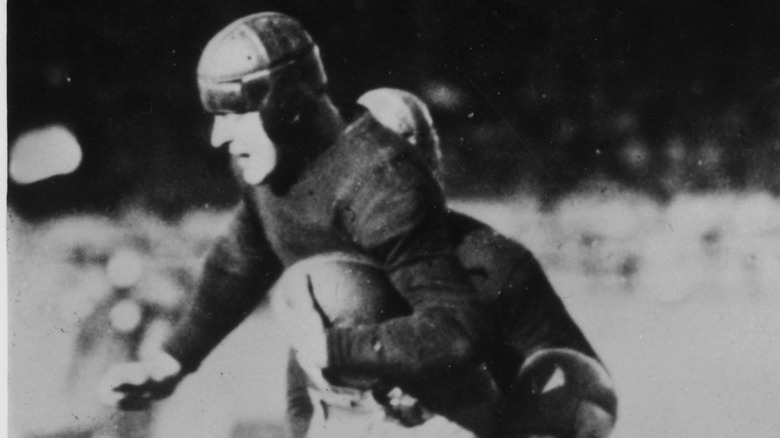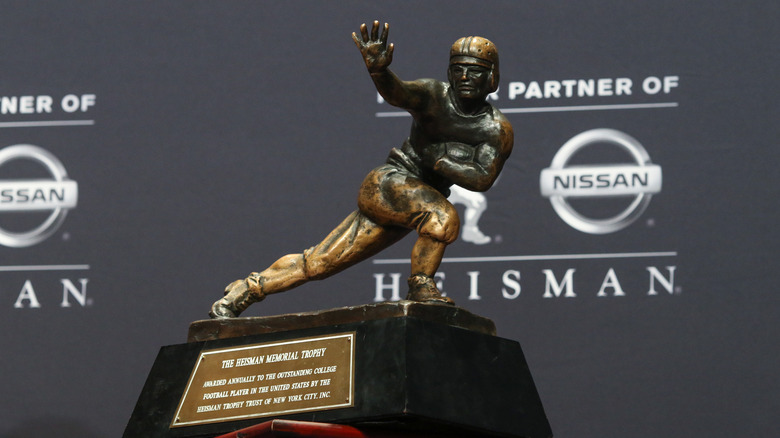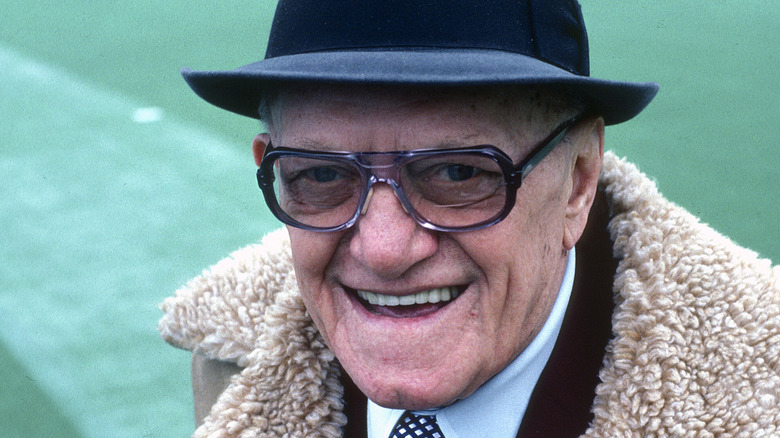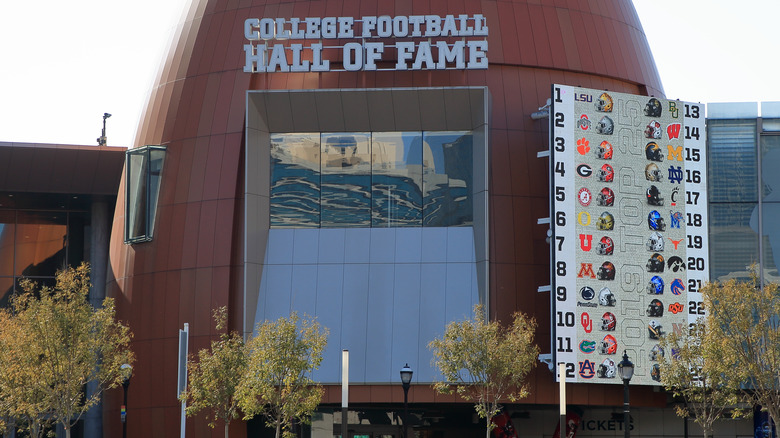Why The First Player Selected In An NFL Draft Never Played Football
Most young football players dream to one day play in the NFL. The first step to get there is to be picked in the NFL draft. For this reason, it's hard to imagine why any player would be drafted to play in the league, only to turn down the offer. In the very first NFL draft, though, in 1936, that's exactly what happened. That creates a unique distinction for the player in question, Jay Berwanger. He's the first-ever NFL player picked in the draft, and also the first NFL draft pick to never play a down in a game, as Bleacher Report explains.
But, why would any young player, who grew up with dreams of gridiron glory, ever do such a thing? Turns out, it's not unheard of, as MassLive reports. Every year some 259 players selected on average for each draft (via Pro Football Network). Yet, in the years spanning 2009 through 2019, 15 NFL players were drafted, but for various reasons, never touched a ball in an NFL matchup. When that very thing happened for the first time, though, the NFL game was quite different. One thing, however, remained the same: The issue that prevented the first-ever NFL draft pick from taking the field concerned money.
The first-ever NFL draft pick played both sides of the ball
According to the official Heisman website, Jay Berwanger, who was also a wrestling and track star while in school, was born in 1914 in Dubuque, Iowa. At that time, football was played on all levels in what's sometimes called the single-platoon system, meaning players played both sides of the ball, moving from offense to defense. By the 1960s, two-platoon football — maintaining separate squads for offense, defense, and special teams — was widely accepted everywhere, per "Border Wars: The First Fifty Years of Atlantic Coast Conference Football," by K. Adam Powell.
For his part, Berwanger played single-platoon football all throughout his career in the '20s and '30s, and as the official Heisman website tells it, he excelled in the system, calling plays, blocking, tackling, and running the ball. He even kicked extra points, among other plays. This earned Berwanger nicknames like "the one-man team," which it's safe to assume, caught the attention of NFL scouts when the first NFL draft came around.
He was the first player to win the Heisman Trophy
Jay Berwanger chose to go to the University of Chicago on a scholarship of $300 a year for tuition — just another example of how times have changed since his era. While there, the accolades and awards came quickly, including the Silver Football from the Chicago Tribune for the most valuable player in the Big Ten — the league in which the University of Chicago football team (called the Maroons) played at that time (via Heisman). Another notable fact from Berwanger's college days: He gave a future president of the United States, Gerald Ford, a scar after the plucky Michigan player tackled Berwanger in the second quarter of a 1934 game.
In those days, the Heisman trophy was not called the Heisman at all, but instead, it was just an award for being the "most valuable football player east of the Mississippi," and simply called the Downtown Athletic ClubTrophy, as the Heisman website explains. Nevertheless, in 1935, Berwanger is considered the first recipient of what one year later became the Heisman Trophy at Manhattan's Downtown Athletic Club. Although stats weren't kept in back then like they are now, it's believed that Berwanger's college playing career was exemplary.
Berwanger entered the first-ever NFL draft in 1936
For this reason, Jay Berwanger was likely on the top of many NFL teams' radar in the 1936 draft — the first ever to take place. According to Pro Football Reference, the Philadelphia Eagles had the first pick that year, and they chose Berwanger. Shortly thereafter, though, the Chicago Bears, coached by George Halas (pictured), negotiated for Berwanger, and it seemed like he might remain in the town where was a college football star.
Before the ink was dry on the deal with the Bears, though, Berwanger and Halas had to reach an agreement on salary. Berwanger held firm for $25,000 over two years but that was too rich for Halas and the Chicago NFL franchise, as Bleacher Report notes. What team wouldn't — in the modern NFL — sign a prospect like Berwanger for such little money? Given that typical rookie salaries in the modern NFL are now at a bit more than $600,000, signing a prospect like Berwanger for $25,000 seems like a no-brainer. Although, according to Dollar Times, $25,000 still equals just about $500,000 in today's money — no small amount in that era. Berwanger and Halas were left at an impasse, and Berwanger never joined the team.
He chose a career as a foam-rubber salesman instead
Instead of playing in the NFL with the Chicago Bears, Jay Berwanger left behind his NFL contract entirely and chose to make his money as a foam-rubber salesman. He also became a naval officer during World War II, and after that, he started his own company producing automotive and tractor parts made from rubber and foam. His company's base of operation remained in Illinois (via Heisman). Although Berwanger's NFL playing days would not come to pass, he kept his hand in the game as a sportswriter for the Chicago Daily News, as a coach, and as a referee.
Berwanger even played a small part as himself in a movie called "The Big Game," the very same year he was drafted. Besides his status as the first player to win what would later be called the Heisman Trophy, the first player drafted, and to also turn down a spot in the NFL, Berwanger's football legacy is secure in two other ways: He was inducted into the College Football Hall of Fame in 1954, and Sports Illustrated tapped Berwanger for their 25-year anniversary All-America team in the `80s. Jay Berwanger sadly died in 2002.
